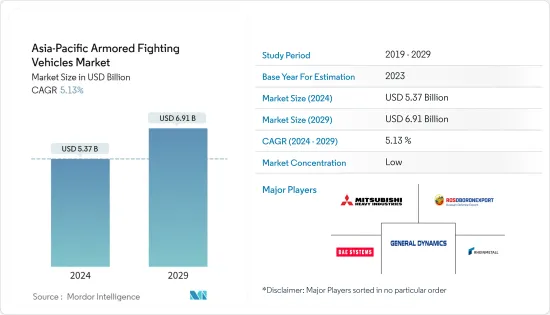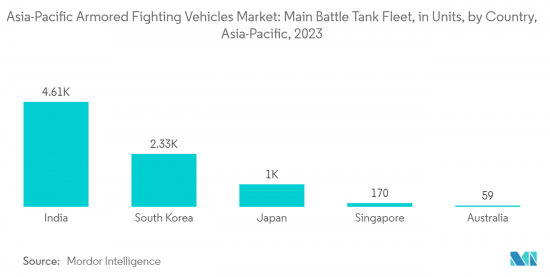PUBLISHER: Mordor Intelligence | PRODUCT CODE: 1406112

PUBLISHER: Mordor Intelligence | PRODUCT CODE: 1406112
Asia-Pacific Armored Fighting Vehicles - Market Share Analysis, Industry Trends & Statistics, Growth Forecasts 2024 - 2029

The Asia-Pacific Armored Fighting Vehicles Market size is estimated at USD 5.37 billion in 2024, and is expected to reach USD 6.91 billion by 2029, growing at a CAGR of 5.13% during the forecast period (2024-2029).
The impact of the COVID-19 pandemic on the military industry was considerably low. However, in the military sector, the pandemic led to disruptions in the supply chain. This was caused by lockdowns in some countries, which led to delays in the delivery of the final products.
Nevertheless, the investments in the procurement and development of new armored vehicles remained unaffected. The market showcased a strong recovery post covid due to increased procurement of armored vehicles and growing defense expenditure.
The existent geopolitical rift, coupled with the increased threat of terrorism and cross-border infiltration, has driven the demand for armored fighting vehicles in the Asia-Pacific region. Several countries in the region have initiated fleet modernization plans. Hence, several contracts are underway to replace the aging fleet of armored vehicles with newer generation vehicles in the upcoming period, thereby driving the growth of the market.
Asia-Pacific Armored Fighting Vehicles Market Trends
Main Battle Tank Segment is Expected to Lead the Market during the Forecast Period
The main battle tank (MBT) segment is driven by the increasing procurements of tanks by various countries, like India, South Korea, and Australia. Defense forces in Asian countries focus on enhancing defense capabilities due to rising cross-border conflicts and growing political disputes among neighboring countries. For instance, in January 2022, Australia announced that it was to modernize its land warfare capabilities under a USD 2.5 billion deal that was expected to provide its Army with 75 M1A2 SEPv3 Abrams tanks, together with armored support vehicles. The new Abrams tanks are being procured under the Main Battle Tank Upgrade, formally known as LAND 907 Phase 2.
In May 2023, South Korea's Defense Acquisition Program Administration (DAPA) approved the mass production of a fourth batch of the Hyundai Rotem K2 main battle tank (MBT) for the Republic of Korea Army (RoKA).
In addition, in January 2022, the Malaysian Ministry of Defence (MINDEF) confirmed its acquisition of additional tanks and armored vehicles for the Malaysian Army under its 2022 Action Plan (PT22). These involved the delivery of 7 units of Pendekar main battle tanks and 31 units of Gempita 8x8 armored vehicles to strengthen the Malaysian Army's capabilities. All these factors are expected to help the market's growth in the region during the forecast period.

India is Expected to Generate High Demand During the Forecast Period
India is anticipated to show remarkable growth in the market during the forecast period. Increasing cross-border conflicts with China and growing expenditure on procurement of defense equipment to improve defense capabilities boost the market growth. According to the Stockholm International Peace Research Institute (SIPRI) report published in 2022, India was the fourth largest defense spender in the world with a defense budget of USD 81.4 billion.
Several instances of cross-border terrorism and illegal incursions have necessitated the investment of financial and technical resources to procure or develop advanced armored vehicles. For instance, in December 2022, the Indian Army revealed that an acceptance of necessity was granted for the procurement of new Futuristic Infantry Combat Vehicles (Tracked).
As of February 2023, the US government may allow the Transfer of Technology (ToT) for the Stryker armored personnel carrier (APC) to India. Although it is not yet clear whether the Indian Army is willing to go for a domestically produced APC over imported ones, the deal for the Stryker armored personnel carrier (APC) is expected to provide a boost to India's defense manufacturing industry. India is also planning to procure mine-protected vehicles for troop movements, especially in radicalism-afflicted areas, such as Jammu and Kashmir (J&K). Such inductions would drive the market to focus during the forecast period.
Asia-Pacific Armored Fighting Vehicles Industry Overview
The armored fighting vehicles market in Asia-Pacific is fragmented, with several global and local defense firms competing based on product innovation and cost. Some of the key players in the market are General Dynamics Corporation, Rheinmetall AG, JSC Rosoboronexport (Rostec State Corporation), BAE Systems plc, and Mitsubishi Heavy Industries, Ltd.
Due to the high demand anticipated from the Asia-Pacific region, several European and American companies are collaborating with local firms to receive new contracts. Smaller firms are also partnering with leading OEMs of armored vehicles for the development of new vehicles. Such partnerships enhance the supply chain as well as improve the technical know-how. In March 2023, Australia announced the biggest export deal of USD 3 billion by supplying Boxer combat vehicles built in Queensland to the German military.
Additional Benefits:
- The market estimate (ME) sheet in Excel format
- 3 months of analyst support
TABLE OF CONTENTS
1 INTRODUCTION
- 1.1 Study Assumptions
- 1.2 Scope of the Study
2 RESEARCH METHODOLOGY
3 EXECUTIVE SUMMARY
4 MARKET DYNAMICS
- 4.1 Market Overview
- 4.2 Market Drivers
- 4.3 Market Restraints
- 4.4 Porter's Five Forces Analysis
- 4.4.1 Bargaining Power of Suppliers
- 4.4.2 Bargaining Power of Buyers/Consumers
- 4.4.3 Threat of New Entrants
- 4.4.4 Threat of Substitute Products
- 4.4.5 Intensity of Competitive Rivalry
5 MARKET SEGMENTATION
- 5.1 Type
- 5.1.1 Armored Personnel Carrier (APC)
- 5.1.2 Infantry Fighting Vehicle (IFV)
- 5.1.3 Main Battle Tank (MBT)
- 5.1.4 Other Types
- 5.2 Geography
- 5.2.1 China
- 5.2.2 India
- 5.2.3 Japan
- 5.2.4 South Korea
- 5.2.5 Australia
- 5.2.6 Singapore
- 5.2.7 Rest of Asia-Pacific
6 COMPETITIVE LANDSCAPE
- 6.1 Company Profiles
- 6.1.1 General Dynamics Corporation
- 6.1.2 Rheinmetall AG
- 6.1.3 BAE Systems plc
- 6.1.4 Hanwha Defense
- 6.1.5 Patria Group
- 6.1.6 JSC Rosoboronexport (Rostec)
- 6.1.7 Krauss-Maffei Wegmann GmbH & Co. KG
- 6.1.8 Mahindra Emirates Vehicle Armouring Fz LLC
- 6.1.9 Defence Research and Development Organisation (DRDO)
- 6.1.10 Kalyani Group
- 6.1.11 Mitsubishi Heavy Industries Ltd
- 6.1.12 FNSS Savunma Sistemleri AS
- 6.1.13 Tata Motors Limited
7 MARKET OPPORTUNITIES AND FUTURE TRENDS




